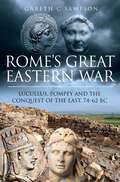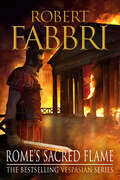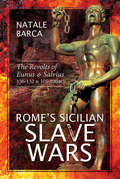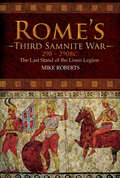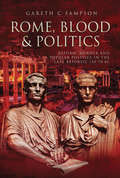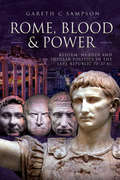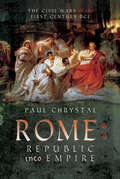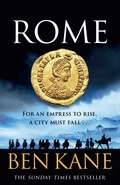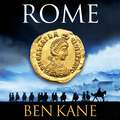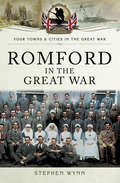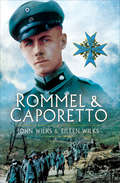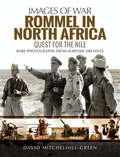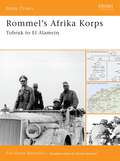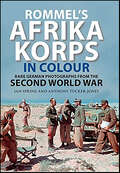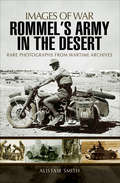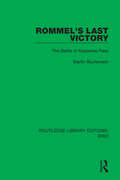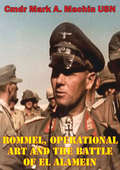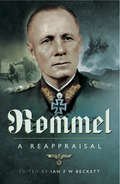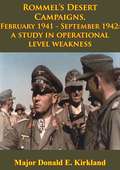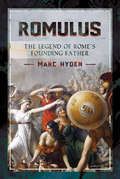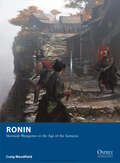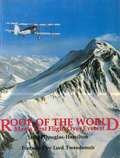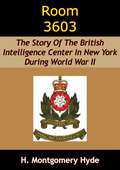- Table View
- List View
Rome's Great Eastern War: Lucullus, Pompey and the Conquest of the East, 74–62 BC
by Gareth C. SampsonThis military history of Ancient Rome analyses the empire&’s revitalized push against rising enemies to the East. In the century since Rome&’s defeat of the Seleucid Empire in the 180s BC, the East was dominated by the rise of new empires: Parthia, Armenia, and Pontus, each vying to recreate the glories of the Persian Empire. By the 80s BC, the Pontic Empire of Mithridates had grown so bold that it invaded and annexed the whole of Rome&’s eastern empire and occupied Greece itself. But as Rome emerged from the devastating effects of the First Civil War, a new breed of general emerged with it, eager to re-assert Roman military dominance and carve out a fresh empire in the east. In Rome&’s Great Eastern War, Gareth C. Sampson analyses the military campaigns and battles between a revitalized Rome and the various powers of the eastern Mediterranean hinterland. He demonstrates how this series of conflicts ultimately heralded a new phase in Roman imperial expansion and reshaped the ancient East.
Rome's Sacred Flame: Sunday Post's Best Reads Of The Year 2018 (Vespasian #8)
by Robert FabbriVespasian has been made Governor of Africa. Nero, Rome's increasingly unpredictable Emperor, orders him to journey with his most trusted men to a far-flung empire in Africa to free 200 Roman citizens who have been enslaved by a desert kingdom. Vespasian arrives at the city to negotiate their emancipation, hoping to return to Rome a hero and find himself back in favor with Nero. But when Vespasian reaches the city, he discovers a slave population on the edge of revolt. With no army to keep the population in check, it isn't long before tensions spill over into bloody chaos. Vespasian must escape the city with all 200 Roman citizens and make their way across a barren desert, battling thirst and exhaustion, with a hoard of rebels at their backs. It's a desperate race for survival, with twists and turns aplenty. Meanwhile, back in Rome, Nero's extravagance goes unchecked. All of Rome's elite fear for their lives as Nero's closest allies run amok. Can anyone stop the Emperor before Rome devours itself? And if Nero is to be toppled, who will be the one to put his head in the lion's mouth?
Rome's Sicilian Slave Wars: The Revolts of Eunus & Salvius, 136–132 & 105–100 BC
by Natale BarcaA study of the two Late Republic slave revolts, exploring their social context, the nature of slavery at the time, and the causes of the conflicts.In 136 BC, in Sicily (which was then a Roman province), some four hundred slaves of Syrian origin rebelled against their masters and seized the city of Henna with much bloodshed. Their leader, a fortune-teller named Eunus, was declared king (taking the Syrian royal name Antiochus), and tens of thousands of runaway slaves as well as poor native Sicilians soon flocked to join his fledgling kingdom. Antiochus’ ambition was to drive the Romans from the whole of Sicily. The Romans responded with characteristic unwillingness and relentlessness, leading to years of brutal warfare and suppression. Antiochus’ “Kingdom of the Western Syrians” was extinguished by 132, but his agenda was revived in 105 BC when rebelling slaves proclaimed Salvius as King Tryphon, with similarly bitter and bloody results.Natale Barca narrates and analyses these events in unprecedented detail, with thorough research into the surviving ancient sources. The author also reveals the long-term legacy of the slaves’ defiance, contributing to the crises that led to the seismic Social War and setting a precedent for the more-famous rebellion of Spartacus in 73–71 BC.Praise for Rome’s Sicilian Slave Wars“An interesting read, and a good account of these large scale and very significant slave uprisings, giving us an idea of what the rebels were attempting to achieve, the methods they chose, and each revolt managed to survive for so long before being crushed.” —History of War
Rome's Third Samnite War, 298–290 BC: The Last Stand of the Linen Legion
by Mike RobertsA compelling account of alliances, animosities, and ancient warfare in central Italy.The Third Samnite War was a crucial episode in the early history of Rome. Upon its outcome rested mastery of central Italy, and the independent survival of both Rome and the Samnites. Determined to resist aggressive Roman expansion, the Samnites forged a powerful alliance with the Senones (a tribe of Italian Gauls), Etruscans, and Umbrians. The result was eight years of hard campaigning, brutal sieges, and bitter battles that stretched Rome to the limit. The desperate nature of the struggle is illustrated by the ritual self-sacrifice (devotio) by the Roman consul Publius Decimus Mus at the Battle of Sentinum (295 BC), which restored the resolve of the wavering Roman troops, and by the Samnite Linen Legion at the Battle of Aquilonia (393 BC), each man of which was bound by a sacred oath to conquer or die on the battlefield.Mike Roberts, who has travelled the Italian landscape upon which these events played out, mines the sources—which are more reliable, he argues, than for Rome’s previous wars—to produce a compelling narrative of this momentous conflict.
Rome, Blood & Politics: Reform, Murder and Popular Politics in the Late Republic, 133–70 BC
by Gareth C. SampsonThis in-depth chronicle examines the series of political upheavals that led to division, violence, and civil war in the ancient Roman Republic. The last century of the Roman Republic saw the consensus of the ruling elite shattered by a series of high-profile politicians who proposed political or social reform programs, many of which culminated in acts of bloodshed on the streets of Rome itself. This began in 133 BC with the military recruitment reforms of Tiberius Gracchus, which saw him and his supporters lynched by a mob of angry Senators. Gracchus&’s grim example was followed by a series of radical politicians, each with their own agenda that challenged the status quo of the Senatorial elite. Each met a violent response from elements of the ruling order, leading to murder and even battles on the streets of Rome. These bloody political clashes paralyzed the Roman state, eventually leading to its collapse. Covering the period 133–70 BC, this volume analyzes each of the key reformers, what they were trying to achieve and how they met their end, narrating the long decline of the Roman Republic into anarchy and civil war.
Rome, Blood & Power: Reform, Murder and Popular Politics in the Late Republic 70–27 BC
by Gareth C. Sampson&“Capture[s] the essence of the struggle within Rome for reform and power and dominance . . . a page turner of a book . . . that offers fresh insight.&” —Firetrench Following the First Civil War the Roman Republic was able to rebuild itself and restore stability. Yet the problems which had plagued the previous seventy years of the Republic, of political reform being met with violence and bloodshed, had not been resolved and once again resumed. Men such as Catiline and Clodius took up the mantle of reform which saw Rome paralyzed with domestic conflict and ultimately carnage and murder. In the search for stability, the Roman system produced a series of military dynasts; men such as Pompey, Crassus and Caesar. Ultimately this led to the Republic&’s collapse into a second and third civil war and the end of the old Republican system. In its place was the Principate, a new Republic founded on the promise of peace and security at home and an end to the decades of bloodshed. Gareth Sampson analyses the various reforming politicians, their policies and opponents and the conflicts that resulted. He charts the Republic&’s collapse into further civil wars and the new system that rose from the ashes. &“[Sampson] has obviously done a huge amount of research, and yet managed to turn what could be a dry subject into an interesting tale of men battling for control. Far more exciting than Game of Thrones, and with added gladiators!&” —Army Rumour Service (ARRSE)
Rome: The Civil Wars of the First Century BCE
by Paul ChrystalRome: Republic into Empire looks at the political and social reasons why Rome repeatedly descended into civil war in the early 1st century BCE and why these conflicts continued for most of the century; it describes and examines the protagonists, their military skills, their political aims and the battles they fought and lost; it discusses the consequences of each battle and how the final conflict led to a seismic change in the Roman political system with the establishment of an autocratic empire. This is not just another arid chronological list of battles, their winners and their losers. Using a wide range of literary and archaeological evidence, Paul Chrystal offers a rare insight into the wars, battles and politics of this most turbulent and consequential of ancient world centuries; in so doing, it gives us an eloquent and exciting political, military and social history of ancient Rome during one of its most cataclysmic and crucial periods, explaining why and how the civil wars led to the establishment of one of the greatest empires the world has known.
Rome: The brand new epic historical adventure for Summer 2025!
by Ben Kane'Historical settings and characters that leap into life straight off the page' SCOTT MARIANI'A vivid page-turning epic' ANNE O'BRIEN'Engaging, immersive, thrilling. Highly recommend for anybody who loves Roman history, written by one of its true masters' PETER GIBBONSFor an empress to rise, a city must fall...Rome, 410 ADHalf-sister to Emperor Honorius, unmarried and powerless, twenty-year-old Galla Placidia watches from the shadows as imperial policies are made and unmade. Her plans to gain power and influence are halted when the city is besieged and captured by a vast army led by Alaric the Visigoth. Taken hostage, travelling out of Italy, Galla Placidia falls in love and marries a barbarian king. At a time when Rome's power is fast dwindling, its authority diminishing year upon year, she embarks on a dangerous and remarkable journey towards the imperial throne.But what price must a woman pay for power?This is the compelling story of a little-known, remarkable woman whose burning ambition saw her, against all odds, become empress of Rome.What your favourite authors have to say about Ben Kane:'A rip-roaring epic' PAUL FINCH'A truly vibrant and gripping read' HELENA GUMLEY-MASON'An epic tale' MATTHEW HARRFY'Historical fiction has never been more visceral' JAMES ROLLINS'A tour de force on an epic scale' DOUGLAS JACKSONReaders are loving Ben Kane:'Powerful evocation of our history' ⭐⭐⭐⭐⭐'An engaging and exciting read' ⭐⭐⭐⭐⭐'Gripped me from start to finish' ⭐⭐⭐⭐⭐'Epic tales, gorgeous prose, non-stop action' ⭐⭐⭐⭐⭐'Rich in period detail and lively in narrative' ⭐⭐⭐⭐⭐
Rome: The brand new epic historical adventure for Summer 2025!
by Ben Kane'Historical settings and characters that leap into life straight off the page' SCOTT MARIANI'A vivid page-turning epic' ANNE O'BRIEN'Engaging, immersive, thrilling. Highly recommend for anybody who loves Roman history, written by one of its true masters' PETER GIBBONSFor an empress to rise, a city must fall...Rome, 410 ADHalf-sister to Emperor Honorius, unmarried and powerless, twenty-year-old Galla Placidia watches from the shadows as imperial policies are made and unmade. Her plans to gain power and influence are halted when the city is besieged and captured by a vast army led by Alaric the Visigoth. Taken hostage, travelling out of Italy, Galla Placidia falls in love and marries a barbarian king. At a time when Rome's power is fast dwindling, its authority diminishing year upon year, she embarks on a dangerous and remarkable journey towards the imperial throne.But what price must a woman pay for power?This is the compelling story of a little-known, remarkable woman whose burning ambition saw her, against all odds, become empress of Rome.What your favourite authors have to say about Ben Kane:'A rip-roaring epic' PAUL FINCH'A truly vibrant and gripping read' HELENA GUMLEY-MASON'An epic tale' MATTHEW HARRFY'Historical fiction has never been more visceral' JAMES ROLLINS'A tour de force on an epic scale' DOUGLAS JACKSONReaders are loving Ben Kane:'Powerful evocation of our history' ⭐⭐⭐⭐⭐'An engaging and exciting read' ⭐⭐⭐⭐⭐'Gripped me from start to finish' ⭐⭐⭐⭐⭐'Epic tales, gorgeous prose, non-stop action' ⭐⭐⭐⭐⭐'Rich in period detail and lively in narrative' ⭐⭐⭐⭐⭐
Rome: The brand new epic historical adventure for Summer 2025!
by Ben Kane'Historical settings and characters that leap into life straight off the page' SCOTT MARIANI'A vivid page-turning epic' ANNE O'BRIEN'Engaging, immersive, thrilling. Highly recommend for anybody who loves Roman history, written by one of its true masters' PETER GIBBONSFor an empress to rise, a city must fall...Rome, 410 ADHalf-sister to Emperor Honorius, unmarried and powerless, twenty-year-old Galla Placidia watches from the shadows as imperial policies are made and unmade. Her plans to gain power and influence are halted when the city is besieged and captured by a vast army led by Alaric the Visigoth. Taken hostage, travelling out of Italy, Galla Placidia falls in love and marries a barbarian king. At a time when Rome's power is fast dwindling, its authority diminishing year upon year, she embarks on a dangerous and remarkable journey towards the imperial throne.But what price must a woman pay for power?This is the compelling story of a little-known, remarkable woman whose burning ambition saw her, against all odds, become empress of Rome.What your favourite authors have to say about Ben Kane:'A rip-roaring epic' PAUL FINCH'A truly vibrant and gripping read' HELENA GUMLEY-MASON'An epic tale' MATTHEW HARRFY'Historical fiction has never been more visceral' JAMES ROLLINS'A tour de force on an epic scale' DOUGLAS JACKSONReaders are loving Ben Kane:'Powerful evocation of our history' ⭐⭐⭐⭐⭐'An engaging and exciting read' ⭐⭐⭐⭐⭐'Gripped me from start to finish' ⭐⭐⭐⭐⭐'Epic tales, gorgeous prose, non-stop action' ⭐⭐⭐⭐⭐'Rich in period detail and lively in narrative' ⭐⭐⭐⭐⭐
Romford in the Great War (Your Towns And Cities In The Great War Ser.)
by Stephen WynnRomford in the Great War tells the remarkable story of Romford and its surrounding areas from the outbreak of the Great War in 1914, to the long-awaited peace of 1918. Romford had a considerable military connection during the war. The area was largely associated with the famous Sportsman's Battalions, the 23rd and 24th Battalions of the Royal Fusiliers, that, as the title suggests, was made up of well-known sportsmen of the day. Initially, the battalion stayed at Hare Hall camp in Romford and Grey Towers Camp in Hornchurch, respectively. The equally famous Artists Rifles took over Hare Hall after the Sportsman Battalion left, and went on to become a renowned officer training corps.The book takes a detailed look at the districts war memorials and rolls of honor, that commemorate the names of the local young men who answered the call to arms to protect their king and country. Wynn explores some of these names in more detail, tweaking out their individual stories of heroism, bravery and devotion to duty no matter what price they had to pay. He also offers a unique flavor of what everyday life was like for the local community, by looking through the local newspapers of the day. A growing paranoia among the masses is addressed, as are the important roles of women, who were keeping the country on top form, whether delivering mail, driving a taxi or working in a local factory, while their husbands, brothers, uncles, sons and fathers were off fighting the war. This is a superb account of the people of Romfords outstanding determination to see the war through.
Rommel and Caporetto (Images Of War Ser.)
by Eileen Wilks John WilksRommel was to become the most respected of all generals in World War Two but no-one outside of a small clique in the German Army had heard of him in 1917. His role at the Battle of Caporetto in 1917 where the Italian Army was humiliated at a catastrophic defeat has received little attention yet it was the springboard for his future success. This makes for a fascinating and important story. The book, by the authors of The British Army in Italy 1917–1918, is based largely on official histories and documents, and on Rommels own account, which gives some insight into the qualities that he was later to exhibit in France and in North Africa.
Rommel in North Africa: Quest for the Nile (Images of War)
by David Mitchelhill-GreenErwin Rommel is the arguably the most well-known German general of the Second World War. Revered by his troops and applauded by his enemies, the so-called Desert Fox achieved legendary status for his daring exploits and bold maneuvers during the North African campaign. In this book, richly illustrated with over 400 images, the author examines the privations and challenges Rommel faced in leading his coalition force. Endeavoring to reach the Nile Delta, we find Rommel's Axis soldiers poorly prepared to undertake such an audacious operation. Much-admired by his men in the front lines, we discover a demanding and intolerant leader, censured by subordinate officers and mistrusted by his superiors in Berlin. Certainly no diplomat, we observe posed interactions with Italian and junior German officers through an official lens. We note Rommel's readiness to take advantage of his enemy's weakness and study his extraordinary instinct for waging mobile warfare. We consider his disregard for the decisive factor of supply and view his army's reliance on captured equipment. We learn how this brave and ambitious commander was celebrated by German propaganda when the Wehrmacht's fortunes in the East were waning. Conversely, analyze why Winston Churchill honored him as a daring and skillful opponent. Finally, we picture this energetic, ambitious, at times reckless, commander as he roamed the vast Western Desert battlefield. This is the story of Rommel in North Africa.
Rommel's Afrika Korps
by Pier BattistelliIn 1940 a British offensive in the Western Desert provoked a major Italian military disaster. By early February 1941 the whole of Cyrenaica had been lost, and German help became necessary to avoid the loss of the entire of Libya. On 14 February 1941 the first echelons of German troops hurriedly arrived at the port of Tripoli, starting the 27-month German engagement in Northern Africa. This book covers the complex and oft-changing organisation and structure of German forces in North Africa from their first deployment through to the conclusion of the battle of El Alamein, an engagement that irrevocably changed the strategic situation in the Western Desert.
Rommel's Afrika Korps in Colour: Rare German Photographs from the Second World War
by Anthony Tucker-Jones Ian Spring"A marvellous collection of original wartime colour photos…For both historians and modellers, the variations in uniforms and their colours will be a great reference..." — Military Model Scene Take a visual journey through North Africa during the Second World War with Anthony Tucker-Jones and Ian Spring as they chart the path of Erwin Rommel and his Afrika Korps through a series of stunning, rare color photographs. Taken from Ian Spring’s incredible digital archive of over 32,000 original color photographs dated between 1936 and 1946, more than 250 images in Rommel’s Afrika Korps In Color offer readers a vivid, detailed insight into this German expeditionary force and their long North African Campaign. Fascinating color photographs of German soldiers, weaponry, tanks and aircraft fill these pages, and are balanced by the equally captivating and rare photographs of the people and the landscapes of North Africa. Renowned author and military historian Anthony Tucker-Jones’ remarkable text accompanies Ian Spring’s collection of rare photographs, together making for a highly informative and utterly engrossing read. Rommel’s Afrika Korps In Color affords readers a new way of reading and learning about one of the most unique campaigns in the Second World War, and will stay with them long after they turn the final page.
Rommel's Army in the Desert: Rare Photographs from Wartime Archives (Images of War)
by Alistair SmithWhen German General Rommel and the lead elements of what would become the Afrika Korps landed in Libya in February 1941, nobody could have foreseen the legendary status they would achieve. Sent to support the faltering Italians, they were eventually able to drive the Allies to the very gates of Egypt. Fighting over hostile and rugged terrain, often outnumbered and outgunned, they were only finally undone by their defeat at El Alamein and Allied landings to their rear.This collection of photographs is taken from the albums of three members of the vaunted Afrika Korps. For the first time the daily reality of the North African campaign can be seen from the German point of view. With numerous photographs of vehicles and men at work, this collection paints a portrait of the rugged and dangerous conditions as well as the harsh and brutal nature of desert warfare.
Rommel's Last Victory: The Battle of Kasserine Pass (Routledge Library Editions: WW2 #28)
by Martin BlumensonThis book, first published in 1968, examines the disastrous defeat suffered by inexperienced American troops, newly landed in North Africa, at the hands of Rommel. The news of Kasserine shocked the United States militarily and politically, and led to swift changes in equipment and tactics. This book traces the battle through to its aftermath in ‘a remarkable piece of battlefield investigation’ (Manchester Evening News).
Rommel, Operational Art And The Battle Of El Alamein
by Cmdr Mark A. Machin USNField Marshal Rommel's North African Campaign demonstrates many of the limitations and restricting factors of modern warfare. Examining the Axis Alliance preparation, implementation and sustainment of its operations provides insight applicable to the warfare commander of today. Relevancy is obtained through analysis of the Axis coalition command and control structure, tactical battle operations, strategic strategy, weapon technology, use of intelligence and logistical support network. Rommel's successful offensive through Libya and Egypt was ended at the Battle of El Alamein due to the critical influence of these factors. His exploits demonstrate excellence of battlefield tactics at the expense of strategic strategy and logistical sustainment.
Rommel: A Reappraisal
by Ian F. BeckettHow should history judge the life and career of Erwin Rommel, the most famous German general of the Second World War, seventy years after his death on 14 October 1944? In his own time and in the years immediately after the war his reputation as a great and chivalrous commander grew to the point where it took on almost legendary proportions, and the legend is still with us today. His apparent support for the plot to remove Hitler from power in 1944 and the manner of his death, committing suicide in order to protect his family from Nazi retribution, further enhanced his image as an honourable, professional soldier.But does he deserve this legendary status? Can his exploits as a soldier and commander and his conduct of the war be separated from the aggressive aims of Hitler and the Nazis whom he and the German army served?These are among the key questions Ian Beckett and his team of expert contributors seek to answer in this stimulating and timely study of Rommel and his legacy. They look critically at every stage of Rommel's brilliant career, from the early fame he achieved as a daring young officer fighting on the Italian front in the First World War, through his exploits as a panzer leader during the German invasion of France in 1940, and his generalship in the Western Desert when he commanded the German and Italian forces fighting the British. These achievements and the publicity that went with them gave him an extraordinary, perhaps overinflated reputation within Germany and among the opposing Allies.As featured in Cornwall Today.
Rommel’s Desert Campaigns, February 1941-September 1942: A Study In Operational Level Weakness [Illustrated Edition]
by Major Donald E. KirklandIncludes the War in North Africa Illustration Pack - 112 photos/illustrations and 21 maps.This study is a historical analysis to determine why Rommel's tactical success on the battlefield could not accomplish strategic objectives in North Africa. Rommel's operations are reviewed from his arrival in North Africa in February 1941 through his last offensive to destroy the British Eighth Army at Alamein in August-September 1942. The study compares his ability to conduct tactical operations with his apparent inability to plan and execute actions at the operational level of war. Rommel's problems with operational planning are addressed within the scope of campaign planning principles set forth in FM 100-5, Operations, (Final Draft). His planning is expressly judged on how he shaped his operational plans by using the concepts of aims, resources, constraints, and restrictions to conform to strategic guidance. Rommel's tactical execution is contrasted with his operational performance. This comparison is based on the AirLand Battle tenets of agility, initiative, depth, and synchronization. The study concludes that Rommel's failure lies in planning operations that exceeded his resources and conducting needless operations that resulted in the loss of the initiative at the decisive point. Rommel's plans exceeded the strategic objectives desired by the theater strategists. His execution was ultimately defeated by his quest for tactical victories without regard to how they contributed to achieving campaign objectives. Rommel's weakness at the operational level led to failure to sequence tactical victories to achieve campaign goals. This failure illustrates the importance of understanding how operational art orchestrates tactical activities to achieve strategic objectives within a theater of operations.
Romulus: The Legend of Rome's Founding Father
by Marc HydenA riveting biography of the legendary founder and first king of Rome.According to legend, Romulus was born to a Vestal Virgin and left for dead as an infant near the Tiber River. His life nearly ended as quickly as it began, but fate had other plans. A humble shepherd rescued the child and helped raise him into manhood. As Romulus grew older, he fearlessly engaged in a series of perilous adventures that ultimately culminated in Rome’s founding, and he became its fabled first king.Establishing a new city had its price, and Romulus was forced to defend the nascent community. As he tirelessly safeguarded Rome, Romulus proved that he was a competent leader and talented general. Yet, he also harbored a dark side, which reared its head in many ways and tainted his legacy, but despite all of his misdeeds, redemption and subsequent triumphs were usually within his grasp. Indeed, he is an example of how greatness is sometimes born of disgrace.Regardless of his foreboding flaws, Rome allegedly existed because of him and became massively successful. As the centuries passed, the Romans never forgot their celebrated founder.This is the story that many ancient Romans believed.Praise for Romulus“Hyden leans into a tone reminiscent of a bard regaling those around a campfire with stories of a hero’s great exploits . . . [He tells] a fascinating origin story.” —Booklist“As inherently fascinating a read as it is an impressive work of meticulous scholarship . . . a truly extraordinary, expressly informative, and highly recommended addition to personal, professional, community, college, and university library Roman History & Culture collections and supplemental curriculum studies reading lists.” —Midwest Book Review
Ronin - Skirmish Wargames in the Age of the Samurai
by Craig Woodfield Jose Daniel PenaRonin is a set of skirmish wargame rules set in late 16th century feudal Japan. Players build small warbands of models and battle each other as well as non-player factions in duels and skirmishes. Ronin is historically accurate, but also pays tribute to the films of Akira Kurosawa such as Seven Samurai and Yojimbo.Despite the enduring popularity of this period, there are very few widely available historical samurai skirmish wargames rules sets. Figures for the period are increasingly available, particularly from Perry Miniatures (very high quality 28mm metal), Wargames Factory (plastic 28mm box sets) and Zvezda (1/72 plastic). Ronin seeks to fill this void with an enjoyable system that is easy and cheap to take up. Gameplay is based upon a d6 system that forces players to make tactical decisions about attack and defence, simulating the cut and thrust of hand-to-hand combat.There are numerous player factions, from Samurai and Ashigaru, the professional soldiers of the period, to Buddhist warrior monks, martial arts schools, and bandits.There are also swords for hire such as Ronin and ninja that players can hire to augment their warband.Players design their warband using a points system, and assign each model weapons, armour and martial skills. Weapons include the yari (pike/spear), naginata (pole arm), yumi (bow), arquebus and of course the katana and its variants. Specialist skills allow a model to undertake various special actions (for example, arrow-cutter provides additional defence against bow fire) or increases the proficiency of the model with a specific weapon.As well as straight warband-on-warband battles, there are specific scenarios, some of them linked to provide a loose narrative. Gameplay is based upon a d6 system that forces players to make tactical decisions about attack and defence, simulating the cut and thrust of hand-to-hand combat. One scenario features the warband defending a notable person from attack by ninjas, another the defence of a village against bandits. There are also campaign rules that allow for the development of a warband in terms of gaining new skills and equipment and planning on-going battles against other players. Finally, very simple guidelines for running a tournament are included.
Roof of the World: Man's First Flight Over Everest
by Lord James Douglas-HamiltonOn the morning of 3 April 1933, two single-engine biplanes set off on a flight into history. From their base near the Indian border with the mystery country of Nepal, the two young pilots, one a British Marquis and a Scottish Member of Parliament, the other a dynamic flight commander, flew towards as great a challenge as world aviation had faced to date - Mount Everest, 'Roof of the World'.The first flight over Everest was the climax of years of thought and months of intensive planning, an epoch-making event which caught the imagination of millions. News of its success reverberated throughout the British Empire to the world at large. Among the deluge of telegrams of congratulations received were those from the King and the Prime Minister. The Times of London, which had given exclusive coverage of the Expedition since its early days, carried one of its longest features ever and was excited enough to comment that the achievement was 'almost like exploring the rainbow'. Some half-a-century later that Houston-Mount Everest Expedition takes its place as one of the last great pioneering flights before the era of space travel.Roof of the World tells the remarkable story of that flight and its repercussions, among which were the growth of the British aviation industry and the creation of the country's second international airport. Using rare and unique photographs, many taken from the flight itself and giving an idea of the qualities required of the crews, Lord James Douglas-Hamilton has recreated the scene facing the pilots, one of whom was his father. He has had access to relevant diaries and personal papers presents in Roof of the World a valuable contribution to our understanding of a unique achievement in an eventful decade.
Room 3603: The Story Of The British Intelligence Center In New York During World War II
by Ian Fleming H. Montgomery HydeThe story of the British Intelligence Center in New York during World War IIWith headquarters in New York at 630 Fifth Avenue, Room 3603, the organization known as the British Security Coordination, or B.S.C., was the keystone of the successful Anglo-American partnership in the field of secret intelligence, counterespionage and "special operations."The man chosen by Sir Winston Churchill to set up and direct this crucial effort was Sir William Stephenson. A fighter pilot in the First World War, he had become a millionaire before he was thirty through his invention of the device for transmitting photographs by wireless. The late General Bill Donovan, director of the Office of Strategic Services, said of him; "Bill Stephenson taught us all we ever knew about foreign intelligence."Sir William Stephenson has now put all his papers and much other relevant material at the disposal of H. Montgomery Hyde, a member of his wartime organization who knows him intimately. The result is a unique picture of the British Secret Service in action and of the remarkable exploits of its brilliant but personally unobtrusive chief in the United States.At the end of the war, J. Edgar Hoover, with whom Stephenson worked closely, wrote to him: "When the full story can be told, I am quite certain that your contribution will be among the foremost in having brought victory finally to the united nations' cause" Now it can be told; Room 3603 is the full story.Ian Fleming's delightful Foreword adds this information: "Bill Stephenson worked himself almost to death during the war, carrying out undercover operations and often dangerous assignments (they culminated with the Gouzenko case that put Fuchs in the bag) that can only be hinted at in the fascinating book that Mr. Montgomery Hyde has, for some reason, been allowed to write--the first book, so far as I know, about the British secret agent whose publication has received official blessing."
Room Full of Mirrors: A Biography of Jimi Hendrix
by Charles R. Cross'Charles R. Cross has got as close to the truth as anyone yet in his exhaustive and ground-breaking account of the life of the greatest guitarist in the history of rock.' Observer'Superb'Sunday TelegraphJimi Hendrix continues to fascinate, and sell huge quantities of albums, even 35 years after his death. Quite apart from his influence on musicians and fans, a large part of the appeal of his sensational life story lies in the thrill of the era whose values he came to stand for. The Sixties still exert a massive pull over pop culture and this is genuinely a book for anyone interested, not only in Hendrix but also in anything to do with the pop culture of the last 40 years.Meticulously researched and sensitively and beautifully written, this is a labour of love that reveals the nuances, foibles and tragedies of the human being behind the iconic image.This is the sweeping, authoritative and colourful biography that Jimi Hendrix and that his legions of fans, young and old deserves.
